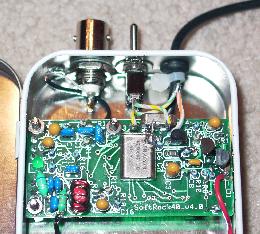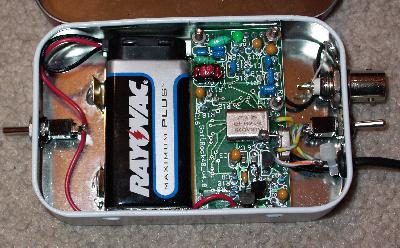I am always amazed at the creativity and downright ingenuity of hams. QRP homebrewers seem to be the cream of the crop in this regard. Witness the AmQRP Club's line of kits, which are nothing short of state-of-the-art electronics at dirt-cheap prices. Wow!
Now, in conjunction with the NJQRP Club, they recently released the "Softrock-40", a minimalist hardware implementation of a full featured 40 Meter receiver. Sounds like a contradiction in terms, but the philosophy is simple, and it works! Namely, keep the hardware as simple as you can, and feed the audio to the soundcard in your PC, so that the PC can do the real work of tuning, detection, demodulation, filtering, agc, and producing a sound fitting for your ears. With such an approach, features undreamed of in a cheap receiver are possible - features like panoramic spectrum displays, tuning with your mouse, and DSP filtering. It's nothing short of amazing, especially when you consider this is done with:
- A printed circuit board about 1 x 3 inches;
- $23 for the entire kit of parts;
- A run-of-the-mill PC with built-in soundcard
- freeware software
The AmQRP Club sold 800 of these kits in two runs, over a period of less than 2 months. That's how much interest there is in this kind of radio. Currently, this particular kit is retired, but the designers are working on the next hardware version. Software is continuously being modified and features being added by various accomplished programmers throughout the QRP community. It really is exciting!
The hardware schema is based on the Tayloe Quadrature Detector, which serves as both the front end and a direct-to-baseband converter. It is driven by a crystal oscillator operating at 4-times the receiver center frequency. It provides a 2-channel I/Q audio output in quadrature channels (that is, 90-degrees shifted). Given I/Q audio, a sound card with stereo inputs, the right software can provide single-signal reception. Depending on your soundcard and it's sampling rate capability, band coverage will be somewhere around +/-12 KHz to +/-24 KHz of the band. The AmQRP kit was designed for 40 Meters, and was designated the SR-40, or "Softrock 40". If you'd like to see a schematic, and pictures of the stock board assembly, go to the AmQRP Softrock webpage. See how simple a radio can really be.
You know I had to get one, and you know I had to modify it ;-)
My Approach (Mods), and Construction Details
The hardware is assembled onto a small pc board. It uses surface-mount IC's, which mount on the bottom side of the board. These are 50-mil pitch, which is easily soldered by anyone with a modicum of soldering experience. We suggest, for success, three things: 1. a pair of head-mounted magnifiersl; 2. a fine-tipped soldering iron (no larger than 1/16-inch tip); 3. simple patience. OK, about half of you dropped out on point No. 3 ;-)
The stock kit is probably just fine, but try as I might, I just couldn't leave it alone. First, it had to go in an Altoids tin. [I know, it's a sickness...]. Secondly, I wanted more than one band, but I wanted it very simply. Actually, I didn't think of that, someone else did, but I jumped on it immediately when I heard the proper crystal was available for a song-and-a-dance. Thirdly, I wanted it to operate from a 9-Volt battery.
The device was intended to operate from the USB port of the PC, plugging into it directly. QRPers quickly figured out that better performance and less noise was possible if you powered it externally, and a 9-Volt battery seemed like a logical choice. But for this, a linear regulator was required, to knock the voltage back down to 5 Volts. I used a 78L05 regulator (in the TO92 package, and a couple of 0.1 uF capacitors for decoupling.
The first thing I had to do (I thought), was chop about 1/8 inch off the USB Connector end of the board. Without the USB connector, the SR-40 pc board fit in the Altoid tin width-wise. Then, because the power circuitry was on that end of the board, I mounted the regulator components there, ugly-construction-style. One of my fellow AQRP'ers showed me his version in an Altoids tin, with a 9-Volt Battery also, and he didn't have to cut down the board. I'm not sure the extra switch for band-switching would have fit in (but it might have).
Because I intended to use a small toggle switch to switch between crystals for 40 Meters and 30 Meters, I needed to find some space to mount a second crystal. The crystal for the 40M version was the small version HC49US, while the crystal for 30M (40.500 MHz) was the full-sized HC49 package. We mounted the larger crystal using double-sided 3M foam taoe, in an area of the board which had just enough real estate, close by the original crystal's location. We left one lead (on each crystal) sticking up in the air, to attach via hookup wire to our band switch.
Here's what those regulator and band-switching mods look like:

And here's what the overall packaging looks like, with the cover open and the 9-Volt battery installed:

Software
There are at least two dominant software packages out there. One, recommended by AmQRP, is a version of the same software used in FlexRadiio's big brother full-featured commercial Software-Defined Transceiver, the SDR-1000. That software package, called PowerSDR 1.4, is available at the Flex Radio web site. Before you install that software, you will need the Microsoft "NET Framework" installed on your computer (available free from Microsoft). For the XP operating system, you'll also need to be running SP1 (the latest service pack from Microsoft). Some people may also need some soundcard interface software, but most (as I understand it) do not if they have a fairly recent PC running XP.
Here are my instructions for installing the software, FWIW:
--------------------------------------------
Installing SDR-40 software for an XP machine
--------------------------------------------
1. Make sure Microsoft NET FRAMEWORK is installed on your PC:
a. Install NET FRAMEWORK (run 'dotnetfx.exe')
b. Install SP1 (security patch; run 'NDP1.1sp1-KB867460-X86.exe')
c. You will be asked to restart the computer
2. Install the Universal ASIO software:
a. run 'A4Av2Ins.exe'
3. Install the PowerSDR Software:
a. unzip 'PowerSDR_v1.4.4.zip'into a temprary folder
b. from the PowerSDR\Install folder, run 'setup.exe'
c. Observe and note the folder where installed
[by default, "C:\Program Files\FlexRadio Systems\PowerSDR v1.4.4\"]
4. Install the SDR Overlay:
a. Unzip 'PowerSDR-1.4.4-SR40-Binary-20050827.zip'
into the folder where PowerSDR was installed
b. run 'PowerSDR.exe'
5. On initial startup, PowerSDR software will enter the Configuration wizard.
a. Answer all the configuration questions "NO",
b. Enter "unsupported soundcard" if your soundcard is not one
of the cards on the list
6. test the software using I/Q WAVE files:
a. 48k_cw10108.wav
b. IK3MAC_CQ_high_noise_12-5-2004_12_46_44_AM.wav
c. From the menu bar in PowerSDR, choose WAVE,
then ADD these files to the playlist
d. to hear them, click the "STANDBY" button to "ON"
Please don't ask me for advice on installing software... I know how I did it (see above), and beyond that, I'm totally ignorant.
One alternate software package, which is receiving rave reviews from users, is offered by VE3NEA, and is available at his web site.
Conclusions
I've tried both software packages on my Dell 2400-Series (El Cheapo) XP machine with integrated soundcard, using the wavefiles (noted above) for testing, and found both software packages to be really cool. I really can't decide which I like better, but I'm leaning toward Rocky right now.
As for the hardware performance, I really can't draw any conclusions yet. I haven't had time to put power on mine and play with it. But feedback from many, many builders indicates it's a really cool little receiver. It is said to have a noise floor of -128 dBm which is very hot. If it works at all - hey, at $23 - how could it be anything less than spectacular?
There is a very active mailing list for this group. Go to softrock40@groups.io. If you have any questions, or want to delve more deeply into this project (and its follow-ons), this is the place to go
73,
Monty N5ESE
dit dididit dit